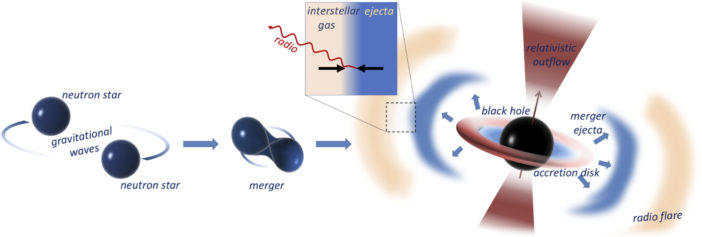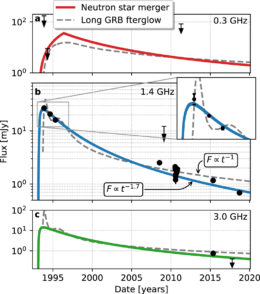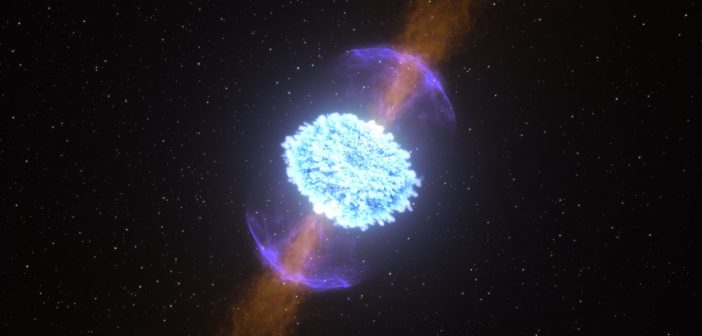When a pair of neutron stars collide, they emit a fireworks show. Could some of the low-energy light produced in these mergers be detectable years later? A team of scientists thinks so — and they’re pretty sure they’ve found an example.
A Rainbow of Signals
In addition to gravitational waves, a slew of electromagnetic radiation is produced in the merger of two neutron stars, spanning the spectrum from gamma rays to radio waves.
In 2017, the now-famous neutron star collision GW170817 gave us a first look at this expected emission: it revealed a short gamma-ray burst, infrared and optical light from ejecta in a kilonova, and relatively short-lived X-ray and radio afterglows caused by high-speed outflows.
But there’s one expected type of emission that was missing from GW170817, and it’s never before been spotted in any neutron star collision: radio flaring.

Illustration of radio emission from a neutron star merger. During the merger, some neutron star matter is flung outward. This ejecta interacts with the interstellar gas, producing a years-long radio flare. [Lee et al. 2020]
Radio Secrets Revealed
Models of neutron star mergers predict that when ejecta are flung out from the stellar collision, they’ll expand into space, eventually running into the surrounding medium of interstellar gas and dust. The subsequent interaction of the ejecta with the interstellar medium should produce radio flaring.
The emission from these radio flares is expected to be quite long-lived — lasting for years or even decades — which means we could hope to find these signals long after the time of the explosion that produced them. But radio flares are also likely to be relatively faint, so we could only expect to spot flares from nearby collisions (within ~650 million light-years). Additionally, only mergers that occur in environments with dense surrounding gas and dust will light up brightly enough for us to spot.
With these constraints, it’s perhaps not surprising that we haven’t found any radio flares marking past mergers yet. But a team of scientists led by Kyung-hwan Lee (University of Florida) recently waded through decades of radio data from the Very Large Array — and in a recent publication, they’re announcing that one transient may be the first identified radio flare from a stellar collision.
A Decades-Old Collision

Observational data for FIRST J1419+3940 and best-fit radio light curves at three different frequencies. The data are better fit by the neutron-star-merger model (solid lines) than the long-gamma-ray-burst model (dashed lines). [Lee et al. 2020]
While this source could potentially be explained as a long-gamma-ray-burst afterglow — light from an off-axis jet produced by a collapsing star — the radio data aren’t fit best by this picture. Instead, the authors show via models that this transient’s light curve is best described as the decay of a radio flare, just as predicted from a neutron star merger. This means that FIRST J141918.9+394036 likely marks a decades-old collision of two stars.
Within a few years, further observations of FIRST J141918.9+394036 will allow us to better distinguish between models and confirm its nature. And as we find more signals like this one, we can use these observations to further understand the origin and physics of neutron star mergers — potentially illuminating everything from the formation channel of binaries to the equation of state for neutron stars.
Citation
“FIRST J1419+3940 as the First Observed Radio Flare from a Neutron Star Merger,” K. H. Lee et al 2020 ApJL 902 L23. doi:10.3847/2041-8213/abbb8a

3 Comments
Pingback: Rozbłysk radiowy ze zderzających się gwiazd? – PTMA Kraków
Pingback: Rozbłysk radiowy ze zderzających się gwiazd? – Astronomia Śląska
Pingback: From AAS NOVA: “A Radio Flare from Colliding Stars?” | sciencesprings